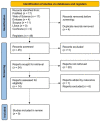Combination of Conventional Drugs with Biocompounds Derived from Cinnamic Acid: A Promising Option for Breast Cancer Therapy
- PMID: 36830811
- PMCID: PMC9952910
- DOI: 10.3390/biomedicines11020275
Combination of Conventional Drugs with Biocompounds Derived from Cinnamic Acid: A Promising Option for Breast Cancer Therapy
Abstract
Despite the options available for breast cancer (BC) therapy, several adverse effects and resistance limit the success of the treatment. Furthermore, the use of a single drug is associated with a high failure rate. We investigated through a systematic review the in vitro effects of the combination between conventional drugs and bioactive compounds derived from cinnamic acid in BC treatment. The information was acquired from the following databases: PubMed, Web of Science, Embase, Scopus, Lilacs and Cochrane library. We focused on "Cinnamates", "Drug Combinations" and "Breast neoplasms" for publications dating between January 2012 and December 2022, based on the PRISMA statement. The references of the articles were carefully reviewed. Finally, nine eligible studies were included. The majority of these studies were performed using MCF-7, MDA-MB-231, MDA-MB-468 and BT-20 cell lines and the combination between cisplatin, paclitaxel, doxorubicin, tamoxifen, dactolisib and veliparib, with caffeic acid phenethyl ester, eugenol, 3-caffeoylquinic acid, salvianolic acid A, ferulic acid, caffeic acid, rosmarinic acid and ursolic acid. The combination improved overall conventional drug effects, with increased cytotoxicity, antimigratory effect and reversing resistance. Combining conventional drugs with bioactive compounds derived from cinnamic acid could emerge as a privileged scaffold for establishing new treatment options for different BC types.
Keywords: breast neoplasms; cinnamates; drug combinations; drug synergism; therapeutics.
Conflict of interest statement
The authors declare no conflict of interest.
Figures




Similar articles
-
GC-MS based comparative metabolomic analysis of MCF-7 and MDA-MB-231 cancer cells treated with Tamoxifen and/or Paclitaxel.J Proteomics. 2020 Aug 15;225:103875. doi: 10.1016/j.jprot.2020.103875. Epub 2020 Jun 10. J Proteomics. 2020. PMID: 32534214
-
Bioactive Compounds in the Ethanol Extract of Marine Sponge Stylissa carteri Demonstrates Potential Anti-Cancer Activity in Breast Cancer Cells.Asian Pac J Cancer Prev. 2019 Apr 29;20(4):1199-1206. doi: 10.31557/APJCP.2019.20.4.1199. Asian Pac J Cancer Prev. 2019. PMID: 31030495 Free PMC article.
-
Caffeic acid phenethyl ester: Inhibition of metastatic cell behaviours via voltage-gated sodium channel in human breast cancer in vitro.Int J Biochem Cell Biol. 2016 Feb;71:111-118. doi: 10.1016/j.biocel.2015.12.012. Epub 2015 Dec 25. Int J Biochem Cell Biol. 2016. PMID: 26724521
-
In-vitro Evaluation of Isatin Derivatives as Potent Anti-Breast Cancer Agents against MCF-7, MDA MB 231, MDA-MB 435 and MDA-MB 468 Breast Cancers Cell Lines: A Review.Anticancer Agents Med Chem. 2022;22(10):1883-1896. doi: 10.2174/1871520621666210903130152. Anticancer Agents Med Chem. 2022. PMID: 34477529 Review.
-
The Effects of Quercetin on the Apoptosis of Human Breast Cancer Cell Lines MCF-7 and MDA-MB-231: A Systematic Review.Nutr Cancer. 2022;74(2):405-422. doi: 10.1080/01635581.2021.1897631. Epub 2021 Mar 7. Nutr Cancer. 2022. PMID: 33682528
Cited by
-
Molecular Pathways of Rosmarinic Acid Anticancer Activity in Triple-Negative Breast Cancer Cells: A Literature Review.Nutrients. 2023 Dec 19;16(1):2. doi: 10.3390/nu16010002. Nutrients. 2023. PMID: 38201832 Free PMC article. Review.
-
In vitro anti-breast cancer study of hybrid cinnamic acid derivatives bearing 2-thiohydantoin moiety.Future Med Chem. 2024 Aug 17;16(16):1665-1684. doi: 10.1080/17568919.2024.2366694. Epub 2024 Jul 1. Future Med Chem. 2024. PMID: 38949859 Free PMC article.
-
Anticancer effects of salvianolic acid A through multiple signaling pathways (Review).Mol Med Rep. 2025 Jul;32(1):176. doi: 10.3892/mmr.2025.13541. Epub 2025 Apr 25. Mol Med Rep. 2025. PMID: 40280109 Free PMC article. Review.
-
The Role of Ferulic Acid in Selected Malignant Neoplasms.Molecules. 2025 Feb 23;30(5):1018. doi: 10.3390/molecules30051018. Molecules. 2025. PMID: 40076243 Free PMC article. Review.
-
Network pharmacology-based approach to investigate the molecular targets of essential oil obtained from lavender for treating breast cancer.Heliyon. 2023 Nov 8;9(11):e21759. doi: 10.1016/j.heliyon.2023.e21759. eCollection 2023 Nov. Heliyon. 2023. PMID: 38034788 Free PMC article.
References
-
- PDQ Cancer Information Summaries. National Cancer Institute (US); Bethesda, MD, USA: 2022. PDQ® Adult Treatment Editorial Board Breast Cancer Treatment (Adult) (PDQ®) pp. 1–5.
Publication types
Grants and funding
LinkOut - more resources
Full Text Sources
Miscellaneous

